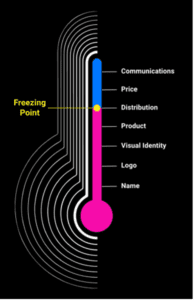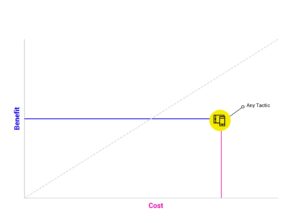Brand Strategy and the Thermometer Model
Is your brand frozen or boiling over?
Franchise brand success is dependent upon how well-defined and implemented the brand is deployed across the franchise system, allowing for some flexibility at a local level without compromising the brand’s global position. Herein lies the challenge: How much flexibility should a brand allow at the local level? A brand can run too hot by not allowing localization and miss out on market capital. Alternatively, a brand can run too cool by allowing too much flexibility, and it becomes less powerful on a global and local level. So how can you know if your brand is too cool or too hot?
The Thermometer Model was coined by Scott Galloway, professor of marketing at New York University Stern School of Business, and is a framework to decide which components of a global brand should remain static across regions (below freezing) and which should be left up to local management (above freezing). Applied to franchise brands, we need to determine how global or local the brand is to determine how much flexibility should be given to local franchisees. And give guidance to Operations Managers to not inadvertently compromise the brand by creating complexity that doesn’t benefit the brand’s growth.
Thermometer Model
A framework to decide which components of a global brand should remain static across regions (below freezing) and which should be left up to local management (above freezing).

How do you decide the brand’s freezing point?
Business is built upon the architecture, identity and associations with the brand. When we deconstruct the brand identity across visual equities and the 4 Ps of marketing – Product, Price, Place, Promotion – we can determine if a brand is global or local.
For example, when you think of McDonald’s what comes to mind? Exactly. Majority of the answers are elements on the thermometer that are frozen. So how does the world’s largest franchise brand establish a freezing point? Let’s deconstruct the elements of the brand. Chart the following along the thermometer – Name, Logo, Visual Identity, Product/Service, Distribution, Price, Communication.
Most brands freezing point is the name, logo and visual identity. When allowing change in any of these three areas, a franchise brand runs the risk of compromising what the brand is known for in market. Imagine if you will 20 different versions of those iconic golden arches. Not so iconic with that much variation.
To best determine freezing points and if there is value in the flexibility is to do a Cost-Benefit Analysis. Ask, is the customization worth the cost?
Cost-Benefit Analysis

Simply look at the tradeoff between marginal benefit and marginal return. If the effort to create the customization on the local level has a higher benefit to the brand, then the freezing point can be lower. If there isn’t a cost-benefit back to the brand, then avoid freezing or unfreezing elements that can be too costly to the brand and/or hinder overall growth of the brand.
How to apply the model?
If your consumer behaves differently across markets, your freezing point may be low. How do you determine what is above the freezing point and what is more fluid? When it comes to applying the framework of the Thermometer Model to your brand, consider the following:
- Is your brand more local or global?
- Identify what falls below the freezing point—your brand non-negotiables.
- Identify what is above the freezing point and what elements of your brand are managed at the local level.
- How much leeway are you willing to give your franchisees across various aspects of your brand (product, price, place, promotion) based on local market needs?
- Are your operations creating growth challenges, from standardizing uniforms to your brand name not being the same in every region?
The Thermometer Model is essential for franchise brands to determine which components of your brand strategy should be localized to remain competitive, and leverage what is best about the brand globally, yet tailoring it for the local market.
Need help in determining if your brand is frozen or boiling over? Let’s talk.


